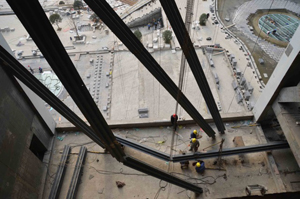 |
| Image ' Lebbeus Woods and Christoph a. Kumpusch |
|
A pavilion designed by Woods in collaboration with Christoph a. Kumpusch is under construction in Chengdu, China. Four stories high, it is a riot of angled steel beams housed in polycarbonate sleeves containing LEDs. |

“I was never in love with drawing,” says Lebbeus Woods, sipping a cocktail in his apartment in Manhattan’s Financial District. “I drew because I wanted to express ideas.” Downstairs, construction work on Nassau Street has revealed a web of pipes and cables eerily reminiscent of Woods’ renderings of order crushed by chaos. Overhead, though a huge skylight in Woods’ living room, Frank Gehry’s 76-story residential tower looms, a reminder of the opportunities available to even adventurous architects who are willing to work within the system.
Woods, 72, has, never worked within the system. Revered in the architecture world as a visionary, his most “permanent” buildings have been installations that remained standing for a few months at most.
But that’s about to change. A pavilion designed by Woods is under construction in Chengdu, China. Four stories high, it is a riot of angled steel beams housed in polycarbonate sleeves containing LEDs. The idea is to see if space can be described entirely with light, says Woods (who collaborated with Christoph a. Kumpusch, an architecture professor at Pratt Institute and Columbia University’s GSAPP). Woods considers it his first permanent work. And he is clear that it is architecture, not art, because people will be able to move through the space. “Maybe you only live there for 10 minutes, but you live there,” he says.
The pavilion is part of a giant mixed-use development by Steven Holl, a longtime friend who, Woods says, fought to have it commissioned and built. It is one of three pavilions incorporated into the complex, including one by Holl himself and one by a local artist chosen by the client. The development is scheduled to be completed in 2013.
In the meantime, Woods has found another champion in Manhattan’s Friedman Benda Gallery, where a stunning show of more than 100 of his early drawings—mostly from the 1980s—is on view through April 7. (If you can’t get there, check it out here.)
The work includes utopian proposals for sections of Paris, Berlin, and New York, as well as dozens of images from Centricity—a project Woods describes as an effort to find an architectural expression of a world in which there is no longer any one center.
Woods hasn’t been to see the show, but he said he has “deep trust” in Henry Urbach, the curator who helped Friedman Benda assemble and install it. The works represent what Woods calls “a very fertile period” and, he says, “were never intended to be sold.” (They were transferred to Woods’s ex-wife as part of a divorce settlement.) But, he says, choosing words carefully, “I’m not unhappy that they’re being sold.” He would prefer that the drawings end up in museums or libraries, rather than in living rooms. “Private collections can be too private,” he says.

Post a comment to this article
Report Abusive Comment